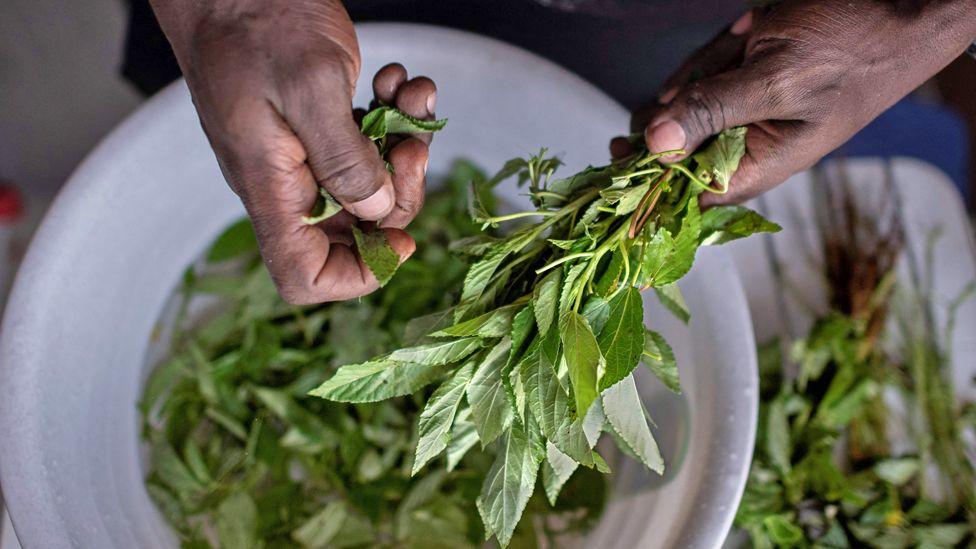The Rise of Indigenous Leafy Vegetables in Kenya
Once considered wild weeds and a “poor man’s food,” indigenous leafy vegetables in Kenya are now gaining widespread recognition. These traditional greens, known as “kienyeji,” are becoming increasingly common, cultivated on farms, sold in markets, and even featured on restaurant menus. This shift reflects a growing appreciation for the nutritional value and cultural significance of these local crops.
At Skinners Restaurant in Gachie, just outside Nairobi, demand for kienyeji is higher than for other greens. Kimani Ng’ang’a, an employee at the restaurant, notes that many customers specifically request these local vegetables, despite the extra cost associated with sourcing them. In contrast, imported greens like cabbage, spinach, kale, and spring greens—known locally as “sukumawiki”—are more readily available and cheaper. Sukumawiki, which translates to “stretch the week” in Swahili, has become a daily staple for many Kenyans.
However, diners in Gachie are part of a broader movement that values the health benefits of indigenous greens. James Wathiru, who ordered “managu” (African nightshade), claims that these vegetables help detoxify the body and support weight loss. Others emphasize the superior taste, stating that the flavor of kienyeji is unmatched.
According to horticulture professor Mary Abukutsa-Onyango, this trend is supported by government data and scientific research. Over the past decade, the production of local greens has doubled, with 300,000 tonnes produced by farmers last year. This shift in attitude marks a significant change from the past, when traditional crops were often dismissed as inferior. Many people failed to recognize that these indigenous plants were naturally more resistant to diseases and pests, making them ideal for organic farming.
In the 1980s, when Prof. Abukutsa-Onyango began her studies, she found that indigenous vegetables were commonly referred to as “weeds.” She recalls being puzzled by the term “pigweed” for amaranth and “spider weed” for spider plant. Her postgraduate research was challenging due to the lack of literature on these plants, but she persisted. Today, she works with the government to promote these crops for food security.
Prof. Abukutsa-Onyango highlights the nutritional superiority of certain indigenous vegetables over imported ones. For example, managu, mrenda (jute mallow), and terere (amaranth) contain higher levels of essential minerals, vitamins A and C, and antioxidants that boost immunity and reduce disease risk. Some varieties also provide protein, making them valuable for vegetarians. A 100g portion of mrenda, for instance, contains more nutrients than a similar portion of common cabbage.
The efforts of researchers like Prof. Abukutsa-Onyango have not gone unnoticed. In 2021, UNESCO recognized Kenya for its work in safeguarding intangible cultural heritage related to traditional foods. The East African nation launched a project in 2007 involving scientists and local communities to document traditional foods, resulting in an inventory of 850 indigenous plants and their local names.
Despite this progress, some imported vegetables remain popular. Sukumawiki, introduced to Kenya from the Mediterranean as animal feed, is still favored by many farmers. In 2023, over 700,000 tonnes of sukumawiki were produced, more than double the volume of all indigenous leafy vegetables combined.
Francis Ngiri, a farmer in Kirinyaga, explains that the dominance of imported crops is partly due to historical practices. In the 1970s, farmers used fertilizers and pesticides that damaged local biodiversity. Today, the soil in many areas is too acidic to support native species. Determined to preserve these crops, Ngiri moved his farm to the Rift Valley, an area less affected by chemical contamination, where he practices organic farming of indigenous crops.
On his four-acre farm in Elementaita, Ngiri started with 14 native varieties in 2016 and now grows 124, many sourced through seed exchanges with fellow farmers. His farm attracts visitors from across Kenya and neighboring countries, showcasing how collaboration among farmers can help preserve forgotten plants and maintain genetic diversity.
However, seed exchange is legally restricted under a 2012 law aimed at protecting farmers from poor-quality seeds. Wambui Wakahiu, a trainer with Seed Savers Network, notes that this policy hinders efforts to save indigenous crop varieties, as their seeds are not available in farm-supply shops. She reports that over 35 traditional plant varieties have been lost in one county alone due to the law.
Dr. Peterson Wambugu, a chief research scientist at Kalro, acknowledges that the current law conflicts with international agreements that allow farmers to save, use, and exchange their seeds. While the national gene bank is working with other groups to revise regulations, the sale of uncertified seeds will still be prohibited. This means the journey toward full acceptance of indigenous crops continues.
For Priscilla Njeri, a vegetable vendor in Wangige market, there is no turning back. She sees firsthand that indigenous greens are now the most popular with her customers. She attributes this to media campaigns that highlight the benefits of these traditional crops. “The most preferred are managu, terere, and kanzira, which is popular for those with sensitive stomachs,” she says. “But all the kienyeji greens are good because they have a better taste.”







